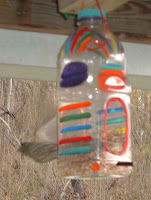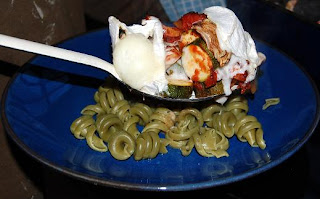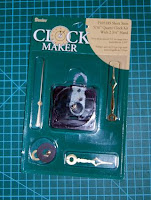





If you make a recycled bird house, please email me a photo, and say whether you're happy for your image to be used on the blog.






 Here is the banner Steph helped me sew together for the kids' school. Eleanor is making her first holy communion this month, and each member of her class painted a sacrament-related design onto a 1' square of fabric. The teacher asked me to assemble all 30 squares into a banner.
Here is the banner Steph helped me sew together for the kids' school. Eleanor is making her first holy communion this month, and each member of her class painted a sacrament-related design onto a 1' square of fabric. The teacher asked me to assemble all 30 squares into a banner. Eleanor's square is the second from the right on the top row. It's a funky-looking yellow bird representing the Holy Spirit, with multicoloured embellishments and glitter. Here it is enlarged. Eleanor always uses colour lavishly in her paintings. Years ago all her class coloured in angels at Christmas time. Most of the children used tasteful combinations of white, silver and gold to colour their angels. Eleanor coloured hers with stripes using every pen in the set; hers was a groovy rainbow hippy angel.
Eleanor's square is the second from the right on the top row. It's a funky-looking yellow bird representing the Holy Spirit, with multicoloured embellishments and glitter. Here it is enlarged. Eleanor always uses colour lavishly in her paintings. Years ago all her class coloured in angels at Christmas time. Most of the children used tasteful combinations of white, silver and gold to colour their angels. Eleanor coloured hers with stripes using every pen in the set; hers was a groovy rainbow hippy angel. When I got the lawnmower out for the first time this year I had to spend half an hour cleaning the grass that was firmly glued to every surface. Last year was a horrible washout and we eventually had to mow the lawn when it was wet, because it never dried out at all and it would have been knee-high if we hadn't mowed it sometime. The wheels of the mower ground up the spongy, waterlogged soil, damaging the lawn. The wet grass didn't cut very well, especially the tough stalks which had developed in the long period between mowing. The soggy grass cuttings stuck to all parts of the lawnmower and were difficult to clean off; eventually we gave up trying. Mowing the lawn in 2007 was a miserable experience.
When I got the lawnmower out for the first time this year I had to spend half an hour cleaning the grass that was firmly glued to every surface. Last year was a horrible washout and we eventually had to mow the lawn when it was wet, because it never dried out at all and it would have been knee-high if we hadn't mowed it sometime. The wheels of the mower ground up the spongy, waterlogged soil, damaging the lawn. The wet grass didn't cut very well, especially the tough stalks which had developed in the long period between mowing. The soggy grass cuttings stuck to all parts of the lawnmower and were difficult to clean off; eventually we gave up trying. Mowing the lawn in 2007 was a miserable experience. I recently wrote a comparison of the an article comparing the nutrient content of food cooked in a pressure cooker and a slow cooker, prompted by Clare of Veg Box Recipes blog who was confused because:
I recently wrote a comparison of the an article comparing the nutrient content of food cooked in a pressure cooker and a slow cooker, prompted by Clare of Veg Box Recipes blog who was confused because:Both claim that their method preserves the highest number of nutrients and gives maximum flavour.
Can they both be right?
 Funny story from the satirical website The Daily Mash.
Funny story from the satirical website The Daily Mash.The Earth spoke out after a series of books, television programmes and environmental campaigns urged people to do everything in their power to 'Save the Planet'.
Earth, 4,000,000,000, said last night: "I'll be absolutely fine, seriously. I might get a bit warmer and a bit wetter, but to be honest, that actually sounds quite nice."
The planet said environmental campaigners should change their slogan from 'Save the Planet' to something more relevant such as 'Save Your Sorry Arse'.

 There are only four days left to participate in our Try A Vegetarian Meal Challenge. If you are running out of inspiration, here are ten good reasons to try a Quorn dish:
There are only four days left to participate in our Try A Vegetarian Meal Challenge. If you are running out of inspiration, here are ten good reasons to try a Quorn dish:Q: Do Quorn products contain genetically modified ingredients?
A: The main component of all Quorn products is mycoprotein, which is not soya-based, but is a member of the mushroom family. This is grown and harvested under strict quality controls and we can therefore reassure you that it is not a product of genetic manipulation.
 Do you ever get those nasty little black flies on your houseplants? Clouds of the buggers fly up whenever you disturb the plant. They're really gross.
Do you ever get those nasty little black flies on your houseplants? Clouds of the buggers fly up whenever you disturb the plant. They're really gross. Clare of Veg Box Recipes blog is confused about the advantages of slow cookers compared to pressure cookers. Specifically she is confused because:
Clare of Veg Box Recipes blog is confused about the advantages of slow cookers compared to pressure cookers. Specifically she is confused because:... the proponents of both pressure cookers and slow cookers claim their method is the best way of cooking food. Both claim that their method preserves the highest number of nutrients and gives maximum flavour.
Can they both be right?

 It was a beautiful spring day here yesterday - bright and still, although cold. So I put on a warm coat and scarf and took lots of photos. I was pleased with this one of a hoverfly.
It was a beautiful spring day here yesterday - bright and still, although cold. So I put on a warm coat and scarf and took lots of photos. I was pleased with this one of a hoverfly.
 Here's another vegetarian recipe my sister Stephanie rustled up whilst she was visiting.
Here's another vegetarian recipe my sister Stephanie rustled up whilst she was visiting. It's a full moon tonight. The moon waxes and wanes as it goes around the earth, so in fact the full moon isn't a date but an instant - the moment when it stops waxing and starts waning. The instant of full moon this month was 10:25am Universal Time April 20th, several hours before I wrote this post. That time was before dawn in the USA, so actually last night's full moon was a bit fuller than tonight's will be, even though the official date of the full moon this month is 20th. It's just one of those weird facts about full moons.
It's a full moon tonight. The moon waxes and wanes as it goes around the earth, so in fact the full moon isn't a date but an instant - the moment when it stops waxing and starts waning. The instant of full moon this month was 10:25am Universal Time April 20th, several hours before I wrote this post. That time was before dawn in the USA, so actually last night's full moon was a bit fuller than tonight's will be, even though the official date of the full moon this month is 20th. It's just one of those weird facts about full moons. I was keeping a nice box just because I liked it. Steph suggested we make it into a clock. Good idea - the box was very shallow, with a square top, about the right dimensions for a clock. So how do you make a clock anyway?
I was keeping a nice box just because I liked it. Steph suggested we make it into a clock. Good idea - the box was very shallow, with a square top, about the right dimensions for a clock. So how do you make a clock anyway? We bought a battery-powered (rechargeable batteries, obviously) clock mechanism from a craft and hobby shop. If you want to make a totally recycled clock you could use a working mechanism from another clock.
We bought a battery-powered (rechargeable batteries, obviously) clock mechanism from a craft and hobby shop. If you want to make a totally recycled clock you could use a working mechanism from another clock. The instructions on the packet told us how big to make the hole for the hands, so we measured the centre of the box precisely, and using a craft knife we made a hole the correct size.
The instructions on the packet told us how big to make the hole for the hands, so we measured the centre of the box precisely, and using a craft knife we made a hole the correct size. We needed to be able to access the clock mechanism to change the time and replace the battery, and we wanted to be able to hang our clock. The bottom of the box fit very snugly on to the top, so we decided to push it back on (but not glue it) and make a hole in the back for hanging. We measured the exact centre of the box, and cut a triangular hole.
We needed to be able to access the clock mechanism to change the time and replace the battery, and we wanted to be able to hang our clock. The bottom of the box fit very snugly on to the top, so we decided to push it back on (but not glue it) and make a hole in the back for hanging. We measured the exact centre of the box, and cut a triangular hole. That's it! Our clock was finished and we hung it on the wall.
That's it! Our clock was finished and we hung it on the wall.All components of the Brita cartridge are recyclable. Cartridges returned to Brita will be returned to our own recycling plant in Germany where the component parts are separated and processed for secondary use. For information on BRITA In-store recycling contact the BRITACare team on 0844 740 4800
In line with growing consumer demand for greener living, BRITA has launched a new in store recycling scheme. Recycling bins are now situated in a range of high street stores such as Robert Dyas, Argos and Cargo. Other major retailer collection points will be following soon.
The BRITA branded bins will be located next to the existing water filter category in store. Customers can recycle any BRITA consumer product filter cartridge, including those for the new BRITA water filter taps.
The Climate Change Bill needs balls if we're ever going to tackle climate change. I will be putting the squeeze on my MP to make sure we have a tough bill. You should too.
By using this sticker on my blog or site I'm digging for victory by...
1. Growing some of my food at home or at an allotment - however modest.
2. Eating locally and seasonally where I can and reducing food miles.
3. Buying from small, local shops where I can and supporting my local economy.
 Spring is springing and new leaves are starting to grow on shrubs and trees. Some of them make tasty herbal tea, so I went out foraging with my 4-year-old niece Rebecca for wild blackberry leaves.
Spring is springing and new leaves are starting to grow on shrubs and trees. Some of them make tasty herbal tea, so I went out foraging with my 4-year-old niece Rebecca for wild blackberry leaves. Rebecca and I picked maybe half-a-pint to a pint of bramble leaves before going home. Actually Rebecca only picked one leaf, then ran off and picked some daisies and dandelions for her mum, leaving me to do all the work. I didn't mind, really.
Rebecca and I picked maybe half-a-pint to a pint of bramble leaves before going home. Actually Rebecca only picked one leaf, then ran off and picked some daisies and dandelions for her mum, leaving me to do all the work. I didn't mind, really. The second difference is that you steep for longer than you would steep normal tea. I'd steep blackberry leaf tea at least half an hour. I've also steeped it a lot longer than that - even a few hours. This time I steeped a jug full for about an hour or so, drank a cup, left the rest steeping overnight, then strained the cold tea into a smaller jug and put it in my fridge.
The second difference is that you steep for longer than you would steep normal tea. I'd steep blackberry leaf tea at least half an hour. I've also steeped it a lot longer than that - even a few hours. This time I steeped a jug full for about an hour or so, drank a cup, left the rest steeping overnight, then strained the cold tea into a smaller jug and put it in my fridge. It's nice hot or cold. I like it better with honey than without. You wouldn't usually add milk, but hey, if you like it that way it's your cup of tea. If you can collect loads of leaves you can dry them and drink wild blackberry leaf tea all year long. After spring the leaves become darker and tougher and don't make such nice tea. But I enjoy it as a spring treat, a fresh taste of the first new greenness of the year.
It's nice hot or cold. I like it better with honey than without. You wouldn't usually add milk, but hey, if you like it that way it's your cup of tea. If you can collect loads of leaves you can dry them and drink wild blackberry leaf tea all year long. After spring the leaves become darker and tougher and don't make such nice tea. But I enjoy it as a spring treat, a fresh taste of the first new greenness of the year. One of the nice things about having my sister Stephanie staying with me is that I eat better, especially at lunch times. I usually just grab anything quick for lunch, but I make more of an effort when other people are here. Steph has been doing a lot of the cooking, too, and todays lunch was a bit of a joint effort.
One of the nice things about having my sister Stephanie staying with me is that I eat better, especially at lunch times. I usually just grab anything quick for lunch, but I make more of an effort when other people are here. Steph has been doing a lot of the cooking, too, and todays lunch was a bit of a joint effort. A couple of weeks ago I announced a competition to win a copy of the book Compost by Ken Thompson. Entrants had to identify what was unusual about the following short review of the book:
A couple of weeks ago I announced a competition to win a copy of the book Compost by Ken Thompson. Entrants had to identify what was unusual about the following short review of the book:K. Thompson's book Compost shows you how to turn scraps and plant cuttings into compost. It shows that it's quick and not at all hard to do. It has lots of full colour photos. This book is good for compost virgins and compost-o-phobics.

 Steph and I went to Homebase today and we spotted a range of eco paints by earthBorn. earthBorn paints are environmentally friendlier because they're VOC free. VOCs are volatile organic compounds - they're the nasties in paint and other things such as paint strippers. They're also what makes new carpets stink, and other plastic things like that. Sick Building Syndrome is thought to be caused by VOCs in paint and carpets etc. They're unpleasant pollutants in the air and water, but confusingly they're also emitted in large quantities by trees, which is why Ronald Regan once said:
Steph and I went to Homebase today and we spotted a range of eco paints by earthBorn. earthBorn paints are environmentally friendlier because they're VOC free. VOCs are volatile organic compounds - they're the nasties in paint and other things such as paint strippers. They're also what makes new carpets stink, and other plastic things like that. Sick Building Syndrome is thought to be caused by VOCs in paint and carpets etc. They're unpleasant pollutants in the air and water, but confusingly they're also emitted in large quantities by trees, which is why Ronald Regan once said:Trees cause more pollution than automobiles do.
 Steph and I spent all day today sewing a banner for the kids' school. My daughter's teacher asked me to help with this project. Every student in her class had painted a design on to a 12" square of fabric. I assembled these into a huge banner with a hanging sleeve at the back and 2" sashing strips separating all 30 squares. I'll take a photo when they hang it up in the school hall - there's nowhere in my house big enough to hang it or lay it flat to photograph it.
Steph and I spent all day today sewing a banner for the kids' school. My daughter's teacher asked me to help with this project. Every student in her class had painted a design on to a 12" square of fabric. I assembled these into a huge banner with a hanging sleeve at the back and 2" sashing strips separating all 30 squares. I'll take a photo when they hang it up in the school hall - there's nowhere in my house big enough to hang it or lay it flat to photograph it.
 I'm not normally a huge fan of eco gadgets. If anyone asked me "What should I buy to save the planet?" my answer would be "Less. Just buy less."
I'm not normally a huge fan of eco gadgets. If anyone asked me "What should I buy to save the planet?" my answer would be "Less. Just buy less." If you would like a chance to win a copy of Compost by Ken Thompson (reviewed here a couple of weeks ago), then here's your chance. All you have to do is identify what is unusual about the following short review of the book:
If you would like a chance to win a copy of Compost by Ken Thompson (reviewed here a couple of weeks ago), then here's your chance. All you have to do is identify what is unusual about the following short review of the book:K. Thompson's book Compost shows you how to turn scraps and plant cuttings into compost. It shows that it's quick and not at all hard to do. It has lots of full colour photos. This book is good for compost virgins and compost-o-phobics.
 In yesterday's post about decorating, Anonymous said...
In yesterday's post about decorating, Anonymous said...Just one little thought - re going to B & Q to buy paint testers - and I mean this kindly......are B & Q now making paint testers of environmentally-friendly paint?
 My sister, Stephanie, is here for a nice long two-week visit. We've plans to meet up a few times with our other sister, Lindsey, for music and fun. I want us to do some work together on the allotment. And she's persuaded me to redecorate the living room which we haven't changed since we moved in five years ago.
My sister, Stephanie, is here for a nice long two-week visit. We've plans to meet up a few times with our other sister, Lindsey, for music and fun. I want us to do some work together on the allotment. And she's persuaded me to redecorate the living room which we haven't changed since we moved in five years ago. April 2nd was the first UN World Autism Awareness Day. Sorry this post is two days late, but I only found out about it yesterday.
April 2nd was the first UN World Autism Awareness Day. Sorry this post is two days late, but I only found out about it yesterday. It's often said that if you're really concerned about your impact on the planet - in terms of carbon emissions, pollution, sustainability and so on - you should become a vegetarian. For example GoVeg.com says:
It's often said that if you're really concerned about your impact on the planet - in terms of carbon emissions, pollution, sustainability and so on - you should become a vegetarian. For example GoVeg.com says:The best thing that any of us can do for the environment is to adopt a vegetarian diet.
It takes up to 10 pounds of grain to produce just one pound of meat. ... The world’s cattle alone consume a quantity of food equal to the caloric needs of 8.7 billion people — more than the entire human population on Earth.

 It's spring time and we've had a few nice days - the kind of day that makes you feel like going for a long bike ride.
It's spring time and we've had a few nice days - the kind of day that makes you feel like going for a long bike ride.